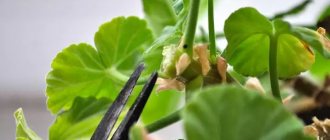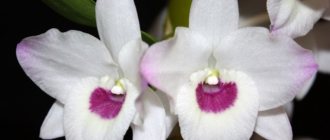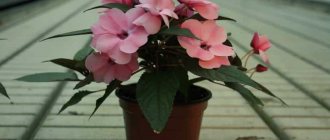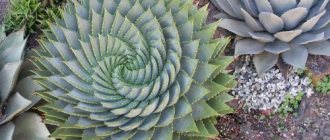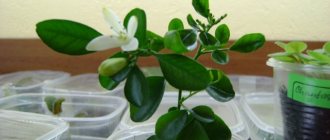The ancient Greeks called this flower “daughter of the wind” (anemone) for its unusually thin and delicate petals, fluttering at the slightest breeze. It received a similar name in Russian - anemone. There are many legends about it, the essence of which boils down to the fact that beautiful anemones are a symbol of sadness and the transience of life. In fact, they look very bright and cheerful, have a huge variety of shapes and colors, for which they are universally loved by gardeners and landscape designers and because of which they often cause difficulties in planting and care. How to plant and grow anemones correctly depends on their variety.
General information
Anemone belongs to the Ranunculaceae family and is a herbaceous perennial with a powerful long rhizome or tuber. The genus includes more than 150 species, blooming at different times and in completely different ways, which confuses even experienced gardeners. They can be 10 cm in height, or reach 1.5 m. The peduncle may be thrown out of the basal rosette, and in other species it may be completely absent.
Distributed in both hemispheres on plains and mountains, with the exception of the tropical zone. Nine species of anemone have become established even in the Arctic Circle, but the most decorative varieties came to us from the Mediterranean countries.
Planting and care according to the category of complexity directly depend on the type of their root system. Rhizomatous varieties are quite easy to grow, but mistakes in caring for tuberous varieties can be expensive.
Conclusion
Anemone is a completely easy-to-care flower, which, nevertheless, has several advantages that determine its popularity. Anemones are extremely diverse (160 varieties), they can easily decorate any flower bed, and are well adapted to the temperate climate of Russia.
In a word, caring for Anemone is pleasant and easy. For this reason, it is perfect for not the most experienced summer residents. On the other hand, excellent appearance and truly inexhaustible possibilities for creating a unique design in the garden are excellent characteristics for avid gardeners.
Classification according to flowering time and shape of the root system
It is, of course, impossible to describe and even list all one and a half hundred species of anemone. But it is convenient to divide them into groups according to their main distinguishing features. We will talk about cultivated anemones and those of their natural varieties that are involved in the creation of numerous hybrids.
Early flowering rhizomatous
Before everyone else, immediately after the snow melts, the buds of the ephemeral anemone open. They have a very short life cycle - immediately after the color fades, the plant itself dries out.
Dubravnaya
The flowers are usually white, but can be pink, beige, lilac or have a greenish tint. They grow in the wild, but also have several garden forms. In height - no more than 10 cm.
Lutichnaya
A taller species, reaching 25cm. The petals are yellow in color; double varieties are grown in cultivation.
Altai
The bud has from 8 to 12 petals, white inside and with a slightly bluish tint outside. Reaches 15 cm. A fairly ordinary variety.
Tuberous mid-early anemones
These species also bloom in the spring, but later, and also have a short growing season. These are the most beautiful varieties among anemones.
crown
The most popular and spectacular, also the most capricious in relation to growing conditions. Planting and caring for it is also far from the easiest. The flowers are similar in shape to poppies, but can be of different colors, both bright and muted tones, including two-tone ones. Up to 45 cm in height. There are simple and terry varieties of garden forms. This species is used as a forcing plant indoors.
Tender (Blanda)
Cold-resistant and tolerant of lack of moisture. It grows up to 15cm, has a large number of cultural forms of various colors.
Sadovaya
Large-flowered species, up to 5-6 cm in diameter, 15-30 cm high. It stands out among other varieties with its openwork foliage and has a large color palette. The tubers of this anemone should be dug up for the winter.
Caucasian
The flowers are light blue, plant height up to 20cm. Cold-resistant, light-loving species that prefers moderate moisture. Apennine
Produces single dark blue buds no more than 3 cm in diameter. One of the most cold-resistant varieties of the tuberous variety, which can overwinter in the ground.
Crown anemone, like other varieties whose tubers must be dug up in winter, begin to bloom in the garden later than their close relatives in natural conditions.
Autumn anemones
Anemones, which bloom buds in August-September, are classified as a separate group. All its representatives are rhizomatous and tall. Flowers of autumn varieties form looser clusters of inflorescences and have “splayed” shoots. Once the plant has taken root, caring for it will no longer be difficult.
Japanese
The average height is 80cm, but some varieties of this variety reach 130cm. Some roughness of the pinnately dissected foliage is compensated by elegant pastel inflorescences, which can be either simple or double in shape.
Hybrid
Stems are medium or tall, up to 120cm. It produces numerous root layers, thanks to which it grows very quickly. The flowers are semi-double, up to 6 cm, in shades of pink to deep crimson, with a bright yellow core. Blooms at the end of summer and continues flowering for a month, prefers partial shade. It is not a winter-hardy species and requires shelter for the winter. Looks great in compositions with ornamental cereals, hydrangea, rhododendron and other spherical plants.
Planting in spring in open ground
You can plant anemones in the spring either by seeds in open ground or by seedlings. Direct planting in open ground in the fall is also practiced. According to the well-established opinion of gardeners, only seed collected in the current season is suitable for autumn sowing. Seedlings are planted in early spring. In both cases, an important rule must be observed: the seeds should not be buried too much due to the fragility of the sprouts, which may not reach the surface. It is enough to simply sprinkle them with earth, preferably through a sieve. At home, you can even leave them on the surface, lightly pressing them against the surface of the soil and moistening them.
Autumn crops will sprout immediately after the snow melts, but here they will face a serious test from the soil oversaturated with moisture. Overwatering can destroy the seedlings completely. Therefore, you should not choose low-lying places for this method of reproduction.
Anemone planted with seeds will produce buds only in the third year!
Top dressing
In terms of feeding, Anemone is one of the most undemanding flowers. Enrichment of the soil with minerals is required only once a year - in the fall. And even then only if no fertilizers were used at all when planting in the spring.
In the summer, when flowering is in full swing, it is allowed to fertilize the top layer of soil with organic fertilizers (but strictly not with fresh manure!).
After applying fertilizers, many gardeners note that it is better to weed and loosen the beds with Anemone. But under no circumstances should you use large hoes for this, as there is a risk of damaging the very thin roots of the bushes.
Preparing seeds before sowing
The seeds of this crop have poor germination (no more than a quarter of the material), so before planting anemones, germination with preliminary stratification is necessary. This concept means simulating wintering conditions without critical temperature drops.
The seeds are placed in a damp sand-peat mixture (1:3) and kept warm for several days until they swell. After this, the soil substrate is moistened again, its volume is slightly increased and the container is moved to a cooler place for a few more days. During this time, the seeds should hatch. And finally, the container with the seeds is sent “for wintering” to a cold place. It is best to bury the container in the ground and cover the top with insulating materials and then with snow.
In the spring, you need to dig up the container as soon as the ground thaws, and plant the anemone seeds for seedlings.
You should know! When propagated by self-collected seeds, the color of the resulting plants is paler than that of the mother plant.
Common mistakes
It can be noted that it is very difficult to make a mistake when growing Anemone. This is a truly unpretentious and very persistent flower. In many ways, it grows completely on its own.
Therefore, the main problems are often associated with trying too hard. The easiest way to spoil Anemone is to water it more than normal. Almost always, the moisture it receives from dew and rain is enough for it.
Quite often, Anemone is dug up every time for the winter. Although in mild winters it is enough to simply cover the flowerbed with leaves and greenery from the harvest.
Finally, do not forget that Anemones are quite whimsical in terms of temperature, preferring coolness and a fresh breeze. On the contrary, too sunny and open areas will adversely affect the growth of this plant.
How to grow anemones from tubers by division
It is best to carry out the procedure in the spring. To do this, tubers dug up in the fall are taken or those that have overwintered are dug up. Using a sharp knife, they are cut into pieces so that each one contains the lower, horse part, and at least one kidney. The cut is sprinkled with wood ash. The resulting planting material is placed in the hole in a horizontal position and sprinkled with a layer of soil no more than 5 cm. The soil is moistened and slightly compacted. Young seedlings obtained in this way will become full-fledged adult plants only in the third year.
Reproduction
You can propagate crown anemone:
- using seeds and
- dividing adult tubers.
When propagated by seed, varietal characteristics are not always preserved, since this plant undergoes quite strong gene splitting. To preserve valuable varieties, it is better to use vegetative propagation.
Propagation by seeds is described above in the section “Growing anemones from seeds.”
To divide tubers, plants older than 5 years are used. The best time for division is spring. Parts are cut off from the tuber with a sharp knife, each of which has 2-3 renewal buds. There is no need to thoroughly clear the soil from the mother tuber before dividing.
Next, the cuttings are processed and planted as described in the section “Planting anemone with tubers.”
Transplanting tuberous varieties
Planting tuberous varieties, which are dug up in winter, is somewhat more difficult than rhizomatous varieties. This process requires preparation. To do this, the tubers must be soaked, but not completely immersed in water, because this will lead to their rotting, because they absorb water like a sponge. To do this, it is recommended to use a cloth soaked in water and well wrung out, in which the seed is wrapped and then placed in a plastic bag. To speed up the process, you can add any biological stimulant to the water. They should stay in the bag for 5-6 hours, no more.
During this time, a small amount of soil mixture is prepared - sand or a mixture of sand and soil, which must be light and permeable. Spread it in an even, shallow layer in a wide container, level it and moisten it moderately, then remove and spread the prepared tubers directly on the surface.
The entire container is placed in a bag and taken out to a cool place. You can cover the container with glass. It is necessary to ensure that the soil is constantly moist, but not wet.
Anemone tubers are planted with the sharp end down, while the flat side should be on top. If it is difficult to determine the top and bottom of unsprouted tubers, they should be placed sideways.
Planting prepared tubers in the ground
You can plant anemone tubers permanently as soon as they take root and form growing points. By this time it will be difficult to confuse where is up and where is down. When planting, the tuber is buried in pots (for growing) or in open ground to two of its heights, but not more than 5 cm. The desired temperature at this stage is not higher than +12C, only in such conditions will the sprouts be strong. Further increases in temperature will no longer harm them. The time to transfer the grown tubers to the garden will come when the street temperature becomes equal to the room temperature. In the first days, it is advisable to shade the young shoots.
How to store in winter and prepare for wintering?
Preparing an Anemone tuber for wintering is quite simple. Conditions for normal storage are no different from similar crops and flowers:
- An ideal place is a basement with minimal access to light and a constant temperature from +1 to +7 C.
- The humidity level is acceptable within 80-100%.
But remember that high humidity along with heat can ruin all the tubers, as they begin to sprout and rot.
Advice: if there is not enough space for all the tubers, then they can be stored in boxes, in several layers. It’s even better if you sprinkle the roots with a layer of wet sand.
One option for storing bulbs is to wrap them in printing paper. Such a lump can be buried in sawdust or sand and thus leave the tubers until spring.
Anemone care
Almost all rhizomatous varieties of the plant tolerate partial shading, while tuberous varieties require more sunlight. Early flowering epiphytes, on the contrary, are shade-loving.
Acidic soils are destructive for all types of this crop. They should be neutral or alkaline, light and loose. Only hand weeding is recommended due to the vulnerable root system.
Watering requirements
Proper moisture is one of the important conditions for growth and flowering. Low humidity is detrimental to decorativeness and growth, while high humidity leads to rotting of the root system. During the active growing season, weekly watering is required; in the summer, if the weather is moderate, watering is not needed. The exception is the crown variety, which must be watered regularly during flowering (avoiding stagnation of water). Mulch helps regulate humidity.
Feeding
During the flowering period, you can feed the anemone with liquid organic matter (with the exception of fresh manure), and in the fall, add complex mineral fertilizers.
Anemone does not tolerate fresh cow manure!
Watering
Anemones do not like too dry and hot climates. Based on this, you need to regulate the frequency of watering.
In the conditions of central Russia, in spring and autumn, it is enough to irrigate the beds with Anemone 1-2 times a week. In summer, when most varieties are at their peak flowering, the frequency of watering should be increased.
But you should pay attention to the fact that if the summer is rainy, then you may not need to additionally water the Anemone bushes.
On the other hand, when there is no rain at all, watering can be done even twice a day: in the morning and in the evening.
Off-season forcing of anemones at home
The plant is one of those that can be forced at home outside the warm season, because their tubers remain viable even during the dormant period. They can be planted at home from September to December, flowering will occur in about 2 months. Pots should be no more than 15 cm in diameter; sandy soil with good drainage is preferable. You can use ready-made soil mixtures for flower crops. During the germination stage, it is important to keep the containers indoors no higher than +12C, and after budding they can be moved to a warm place.
In winter, the plant is easy to flood, because... their growth slows due to lack of sunlight.
After flowering, you need to wait for the foliage to dry, dig up the tuber, clean it from the ground and put it in storage until planting again.
Diseases and pests
Anemones rarely get sick or suffer serious pest attacks..
When growing Anemone, you can sometimes encounter root rot. But it arises only under human influence, namely due to uncontrolled watering.
Sometimes slugs or snails settle on Anemones, which spoil the appearance of the flower. A metaldehyde solution will drive away pests for a long time (use strictly according to the instructions). But, of course, the pests that have already appeared will need to be collected manually.
But if the plant has leaf nematodes or winter worms, then most likely you will have to get rid of the damaged bushes, and remove the top layer of soil under them and move it away from healthy Anemones.
